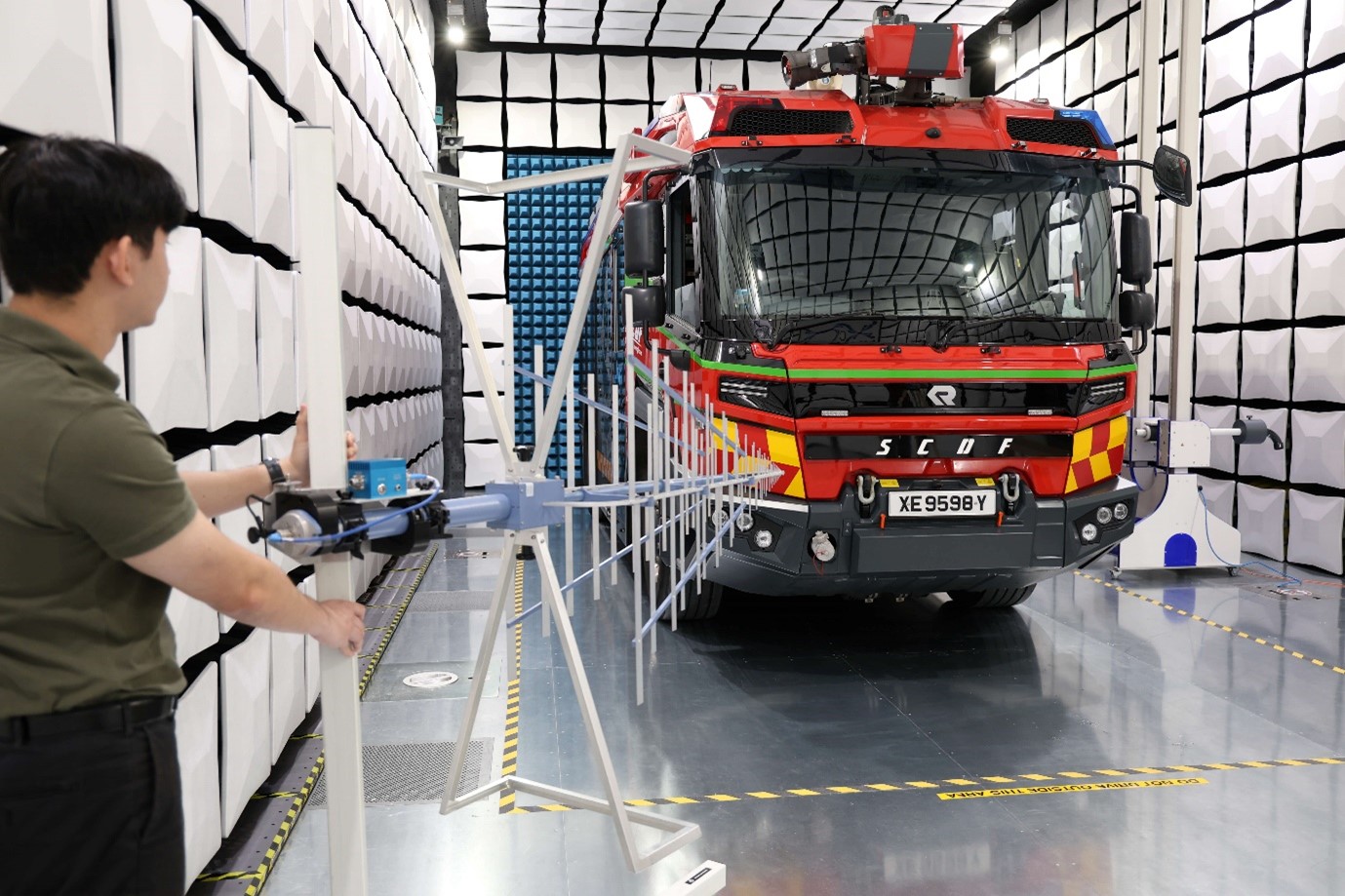 A HTX engineer works in Garage@HTX, HTX’s latest facility. (Photo: HTX/Nicole Lim)
A HTX engineer works in Garage@HTX, HTX’s latest facility. (Photo: HTX/Nicole Lim)
HTX has once again upped the ante in its efforts to force multiply the Home Team, this time focusing on engineering. Specifically, the testing and evaluation that’s baked into engineering to ensure safety and effective operational performance. Such testing requires dedicated facilities for optimal effectiveness.
This is why we’ve launched Singapore’s first purpose-built Developmental Testing and Evaluation (DT&E) facility for public safety.
Called Garage@HTX, the facility was officially opened by Minister for Law and Second Minister for Home Affairs Mr Edwin Tong on 13 October 2025.
Home Team assets like drones, vehicles or communication systems must be comprehensively tested and evaluated for safety and functionality before they are deployed for public safety needs. Garage@HTX gives the Home Team dedicated spaces and tools for such DT&E activities, for the first time.
The facility allows us to accelerate the development and deployment of the Home Team’s capabilities and further build up strong organic engineering capabilities.
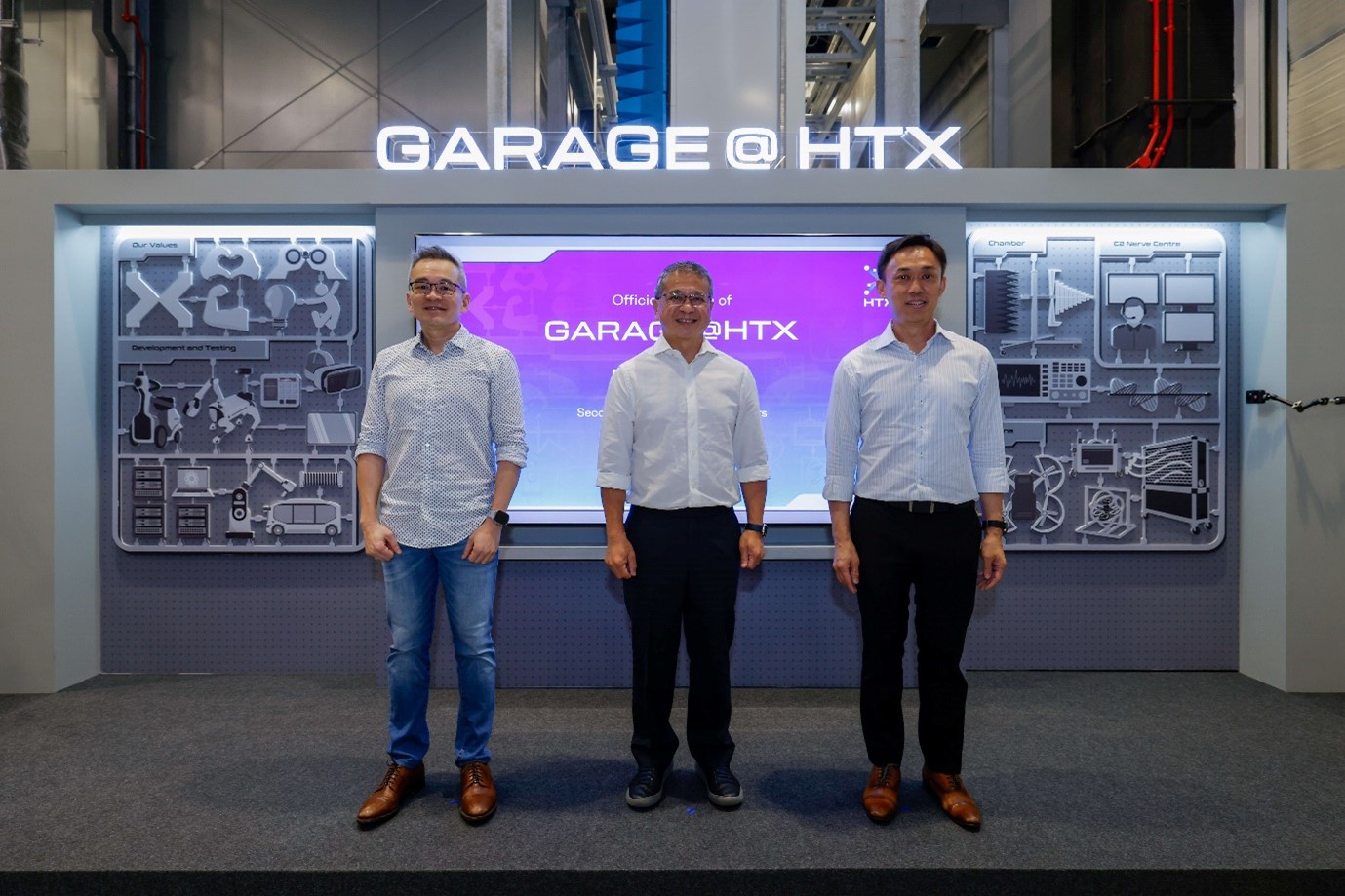 (From left) HTX Chief Executive Mr Chan Tsan, Minister for Law and Second Minister for Home Affairs Mr Edwin Tong, and HTX Chairman, Permanent Secretary (Home Affairs Development), Ministry of Home Affairs and Permanent Secretary (Information and Development), Ministry of Digital Development and Information Mr Tan Chye Hee at the opening of Garage@HTX. (Photo: HTX)
(From left) HTX Chief Executive Mr Chan Tsan, Minister for Law and Second Minister for Home Affairs Mr Edwin Tong, and HTX Chairman, Permanent Secretary (Home Affairs Development), Ministry of Home Affairs and Permanent Secretary (Information and Development), Ministry of Digital Development and Information Mr Tan Chye Hee at the opening of Garage@HTX. (Photo: HTX)
“The Home Team is focused on safety, security of Singapore, and Singaporeans, and it is great to see that HTX is now, yet again, force multiplying – this time, through the setting up of the Garage,” said Mr Tong in his remarks at the opening.
Speaking about the facility’s capabilities, he said, “All of these are going to be important as we look at trialling and eventually deploying on the ground – state-of-the-art, novel, as well as very innovative solutions, all of which are really designed to enhance our solutions for safety, security, and ensuring that Singaporeans get to enjoy the best in terms of security options that can be deployed in Singapore.”
 Minister Tong (left) and HTX CE Chan Tsan share a laugh during the launch event for Garage@HTX. (Photo: HTX)
Minister Tong (left) and HTX CE Chan Tsan share a laugh during the launch event for Garage@HTX. (Photo: HTX)
One-stop shop: Test, refine, re-test
Garage@HTX has four specialised zones, each dedicated to a key field of DT&E.
Co-locating these spaces under one roof makes them more than the sum of their parts, because it enables a continuous cycle of testing, refining and re-testing which ensures that the tech is not only safe, but tailored for the Home Team’s specific needs. This one-stop shop will also enable more effective and efficient collaboration between HTX’s engineers, which will speed up the pace at which HTX rolls out new innovations or evolves existing capabilities.
Here’s an overview of the facility and its four zones:
Electromagnetic Interference (EMI) / Electromagnetic Compatibility (EMC) Chamber
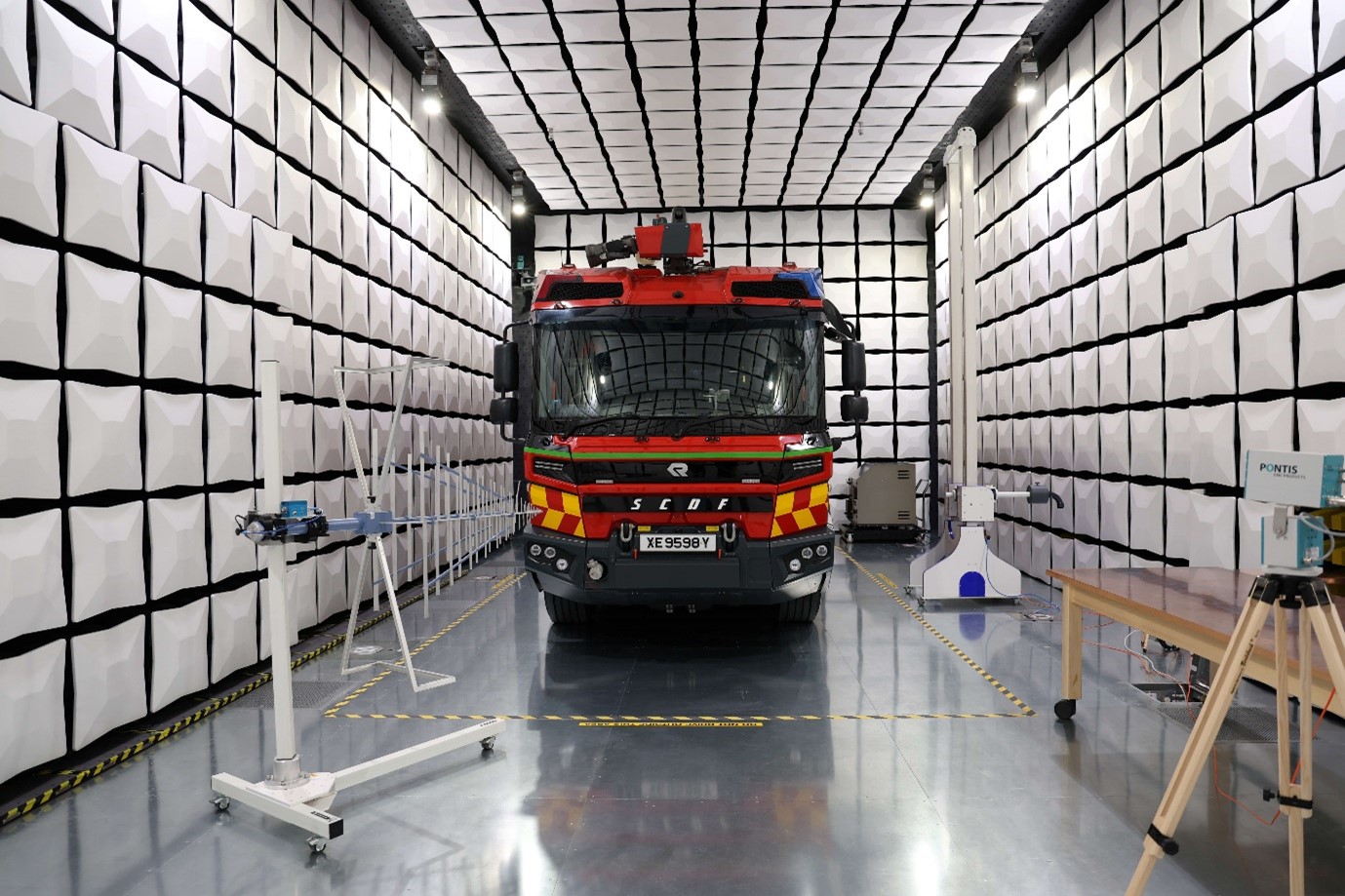 Standing at 16.5m deep, 6.5m wide and 5.5m tall, the chamber was designed to fit some of the largest of Home Team vehicles, such as the Electric Pump Ladder. (Photo: HTX/Nicole Lim)
Standing at 16.5m deep, 6.5m wide and 5.5m tall, the chamber was designed to fit some of the largest of Home Team vehicles, such as the Electric Pump Ladder. (Photo: HTX/Nicole Lim)
The Home Team deploys a wide range of vehicles in its operations, from ambulances to fire engines and electric vehicles (EVs). These often contain a variety of hardware that emits electromagnetic signatures, which may interfere with sensitive electronics on board, such as life-saving equipment.
Testing of EMI and EMC can be conducted in a chamber that was custom built to suit the Home Team’s needs. What also sets this chamber apart is its size – it can accommodate some of the Home Team’s largest vehicles, like the Electric Pump Ladder.
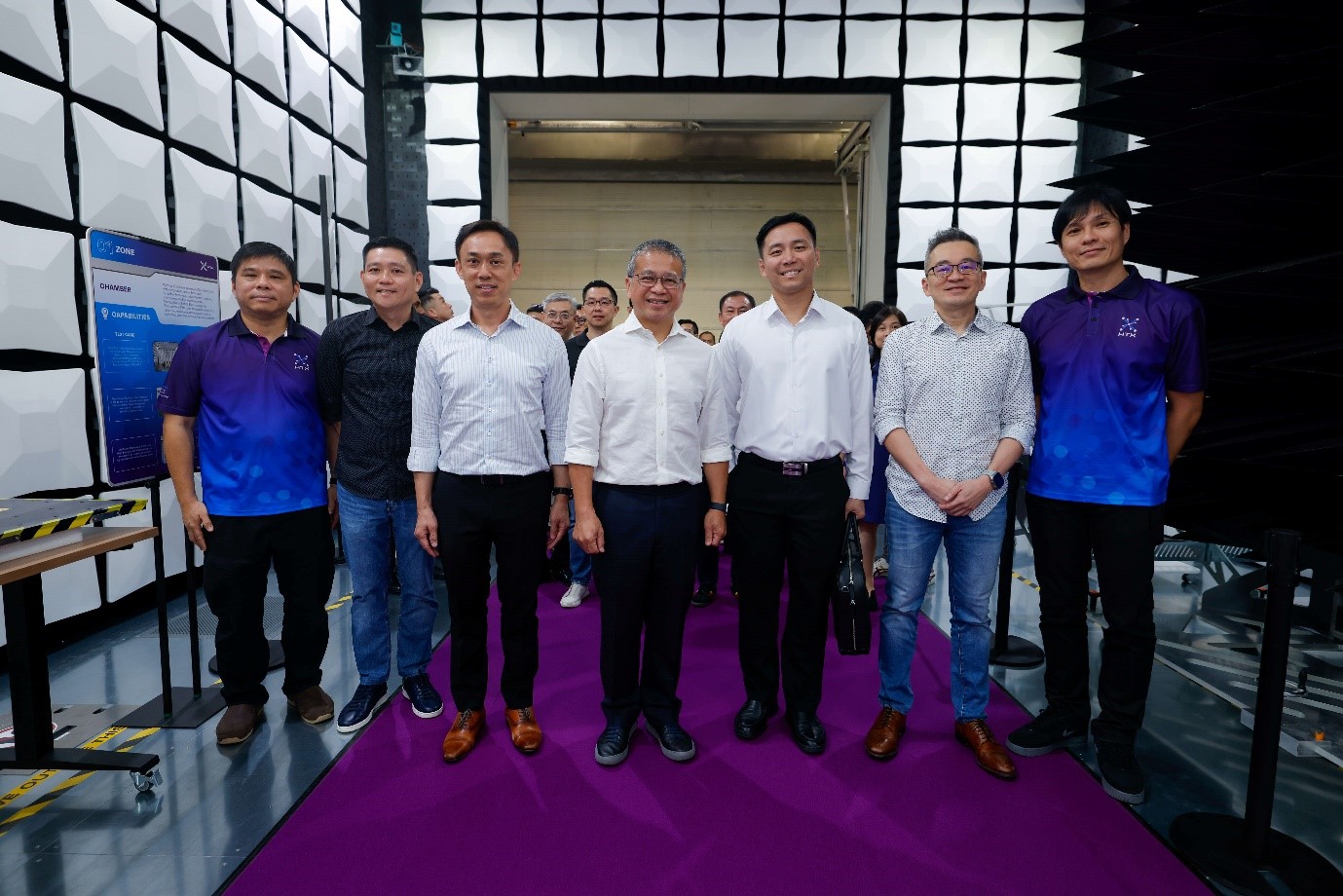 Minister Tong (centre) takes a tour of the EMI/EMC chamber, along with Mr Tan Chye Hee (third from left) and Minister of State, Ministry of Home Affairs and Ministry of Social and Family Development Mr Goh Pei Ming (third from right). (Photo: HTX)
Minister Tong (centre) takes a tour of the EMI/EMC chamber, along with Mr Tan Chye Hee (third from left) and Minister of State, Ministry of Home Affairs and Ministry of Social and Family Development Mr Goh Pei Ming (third from right). (Photo: HTX)
The chamber will also be crucial for the testing and development of the Home Team’s Counter-Unmanned Aerial Systems (C-UAS) capabilities.
(Note: For mobile users, please click the video to view it in the YouTube app for the full 360-degree interactivity.)
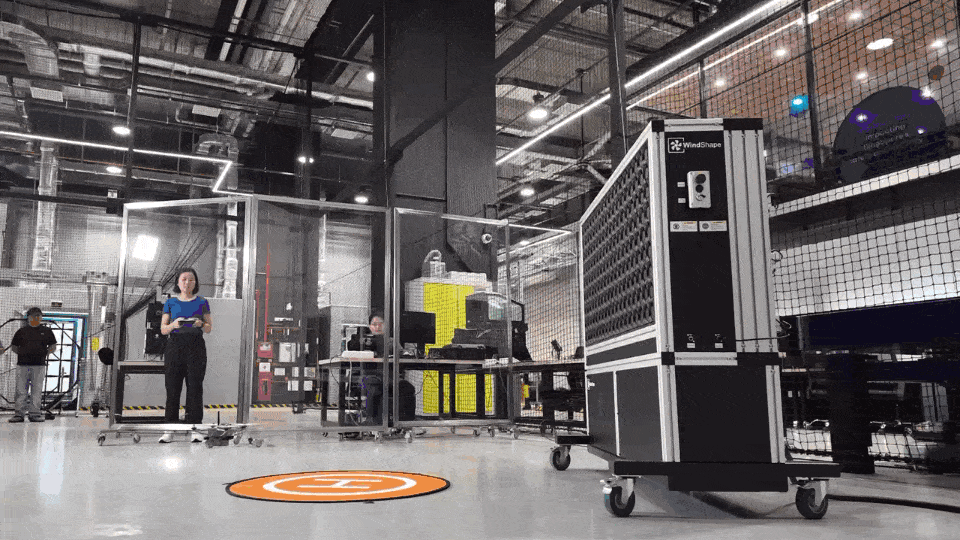 The Arena is a cage-like structure that is 8m high. (GIF: HTX/Rayner Lim)
The Arena is a cage-like structure that is 8m high. (GIF: HTX/Rayner Lim)
This is the zone in which possibilities take flight.
Surrounded by nets, the Arena is akin to a cage in which engineers can safely conduct controlled and repeated testing and evaluation of unmanned aerial systems (UAS), as well as robotic systems such as humanoids.
Such a setting is necessary as drones may veer off intended flight paths and collide with environmental objects during tests.
It is also fitted with a drone performance test rig – which consists of a wind simulator and gyroscope – to simulate realistic conditions.
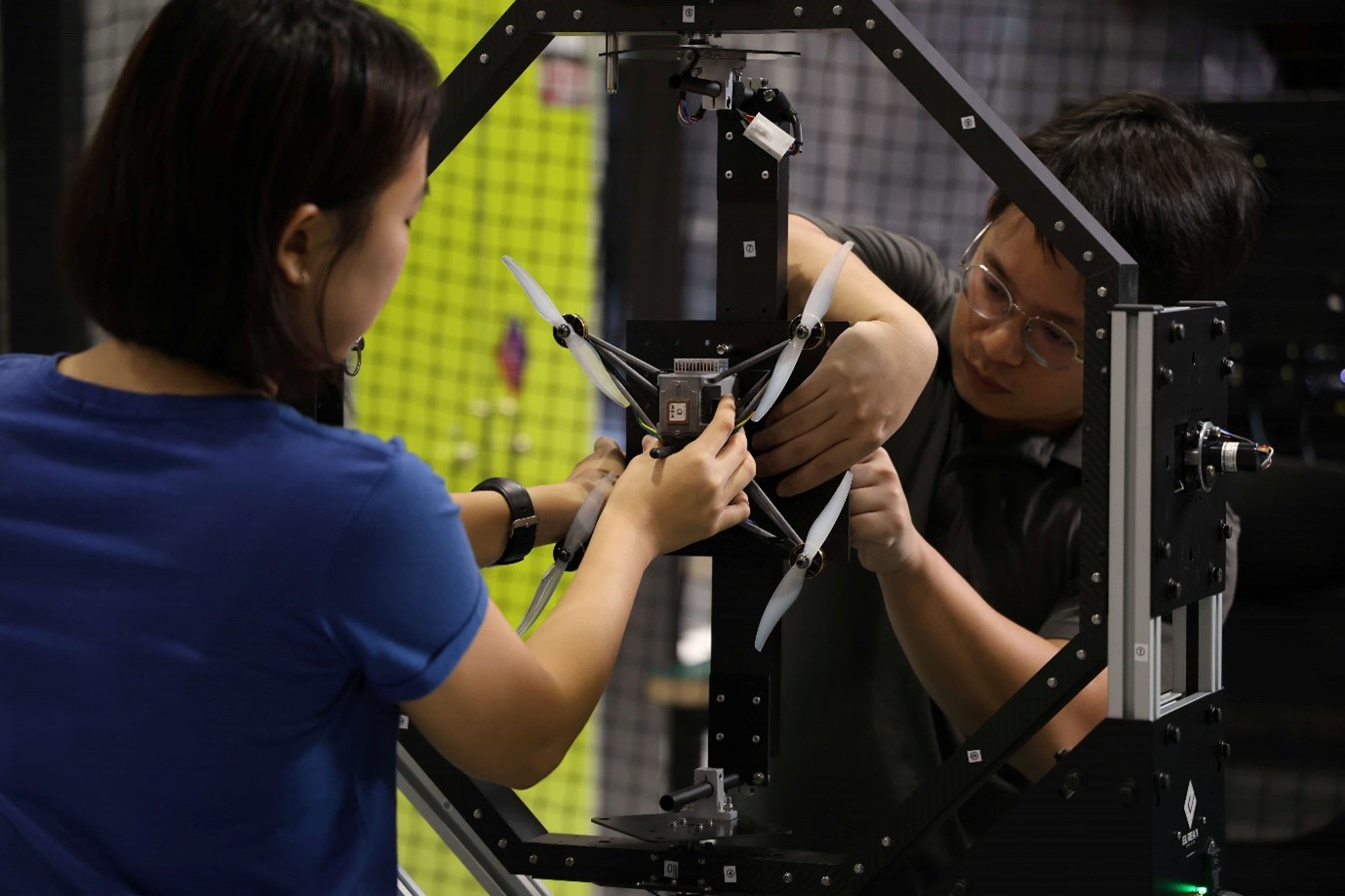 Engineers from HTX’s Robotics, Automation and Unmanned Systems Centre of Expertise (RAUS CoE) attach a drone to the gyroscope for testing. (Photo: HTX/Nicole Lim)
Engineers from HTX’s Robotics, Automation and Unmanned Systems Centre of Expertise (RAUS CoE) attach a drone to the gyroscope for testing. (Photo: HTX/Nicole Lim)
“Testing drones in the Arena is an intermediate step we take before bringing them out into the field,” explained Lee Wing Ho, an engineer from HTX’s RAUS CoE.
“This helps us to ensure that the flight control algorithms are robust, stable and reliable, so we can trust that the drones will be able to respond to varying environmental conditions when brought outdoors.”
Another plus point of this space is engineers can now perform drone tests on demand and without having to worry about weather conditions. Previously, engineers also had to apply for a permit before they could test their drones outdoors. The permits could at times take weeks to be issued.
Development and Testing Area
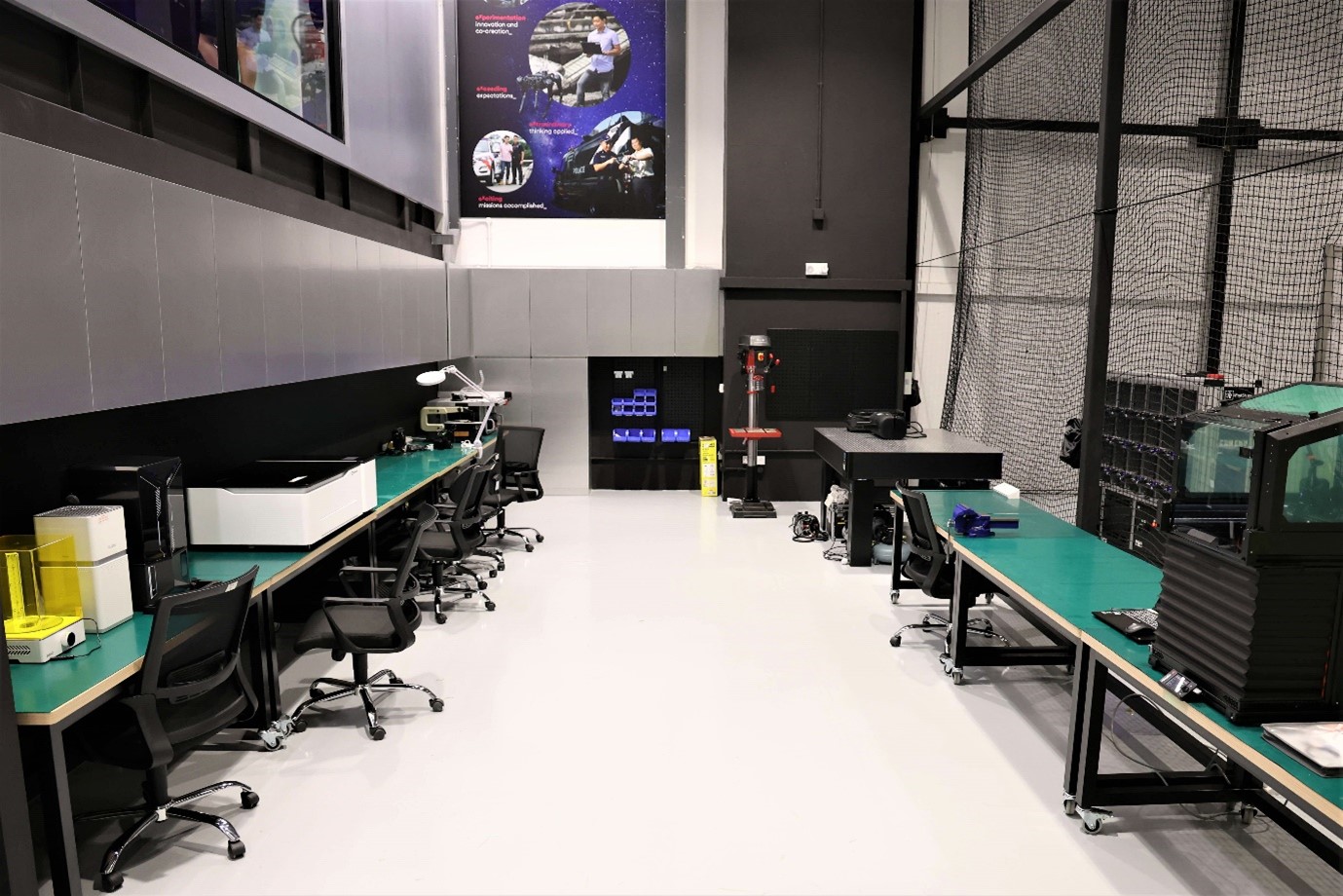 Part of the Development and Testing Area in Garage@HTX. (Photo: HTX/Nicole Lim)
Part of the Development and Testing Area in Garage@HTX. (Photo: HTX/Nicole Lim)
Located next to the EMI/EMC chamber and the Arena, this zone allows engineers to transform their conceptual ideas into working solutions through design, fabrication, integration and testing.
The engineering workbenches are equipped with 3D printers, laser cutters and other precision tools which are essential for supporting mechatronic development and rapid prototyping.
“With Garage@HTX, we can now quickly design a vehicle part, fabricate it through 3D printing, use a laser cutter to slice it to specification and walk just twenty steps to test it out on the vehicle itself. In the past, this process would have taken much longer to complete because testing and vehicle holding spaces were decentralised,” explained Chin Yu Hang, an engineer from HTX’s Vehicle & Weapon Systems (VWS) CoE.
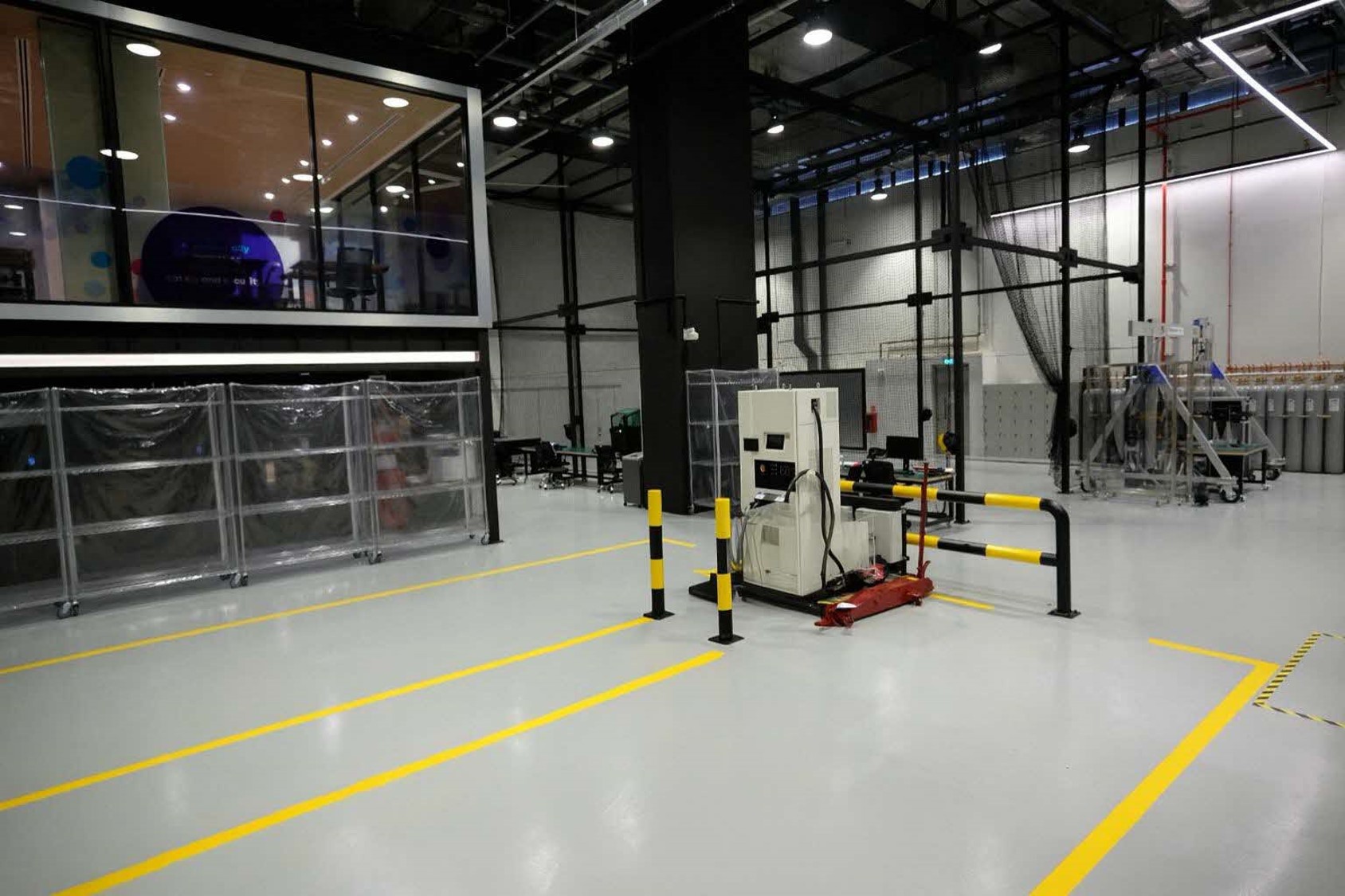 The area also has an EV charger to facilitate integration tests on EVs. (Photo: HTX/Alywin Chew)
The area also has an EV charger to facilitate integration tests on EVs. (Photo: HTX/Alywin Chew)
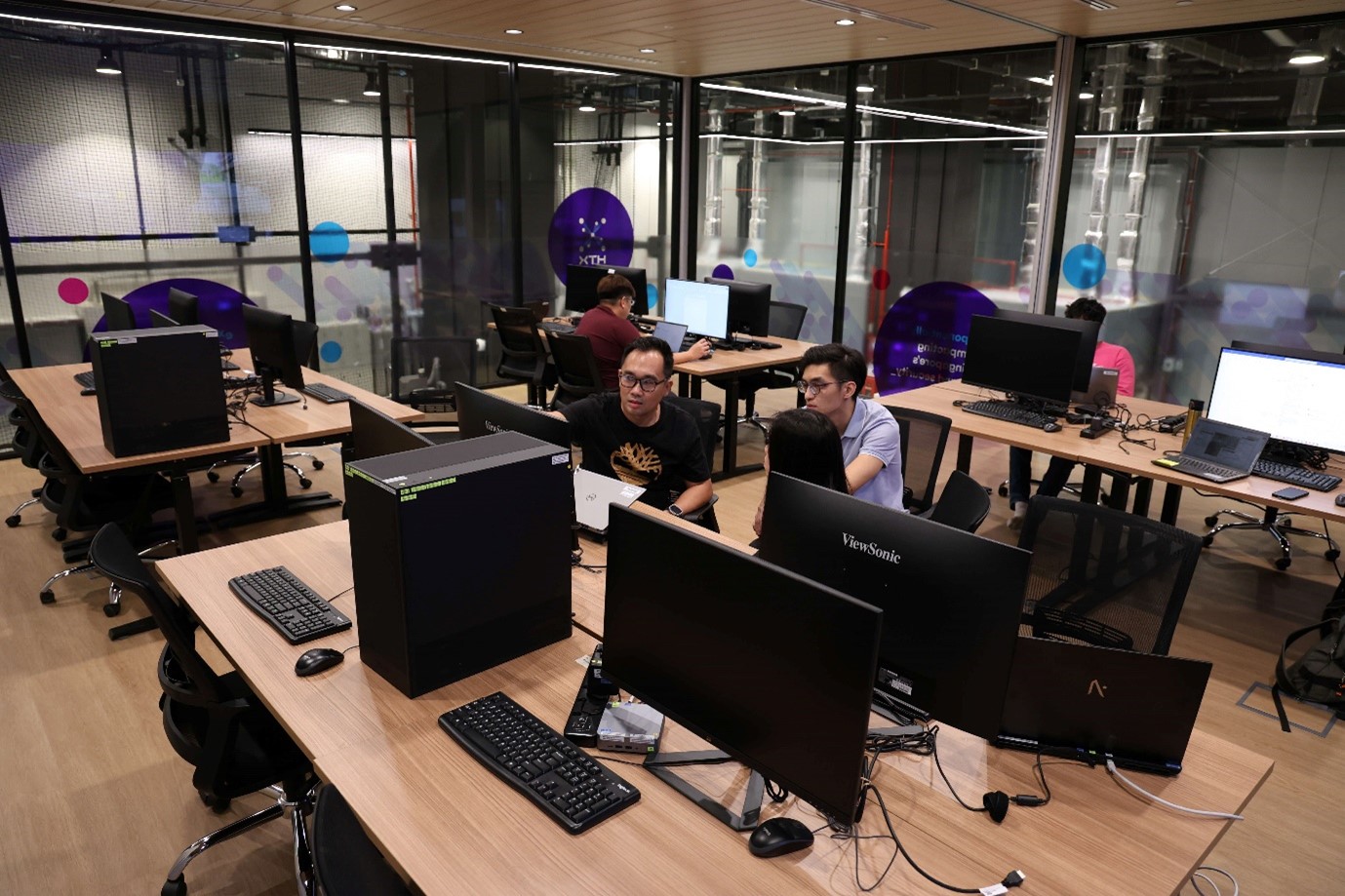 The C2 Nerve Centre. (Photo: HTX/Nicole Lim)
The C2 Nerve Centre. (Photo: HTX/Nicole Lim)
Sitting on the mezzanine floor of Garage@HTX is a C2 Nerve Centre that will be dedicated to the development and testing of C2 software and digital applications for the Home Team.
It is equipped with its own servers, so development and tests can be conducted in sandboxed environments without impacting operational systems.
When needed, it can also be reconfigured into a C2 testbed, or host multiple nerve centres to support the Home Team’s C2 operational needs.
The launch of Garage@HTX also coincided with the latest edition of TechXplore.
HTX Chief Executive Chan Tsan pointed out that Garage@HTX will play a key role in helping the Home Team deal with emerging threats in the public safety space.
“For the Home Team to stay ahead of the curve and be ever ready to tackle new challenges in today’s constantly evolving public safety landscape, it must be equipped with the latest technologies and facilities,” he explained.
“This is why we have set up this facility – to expand our capabilities in leveraging engineering to fulfill our mission of force multiplying the Home Team and allowing it to effectively fend off potential threats like rogue drones, which are becoming more and more prevalent today.”
Find out more about Garage@HTX in this video:

